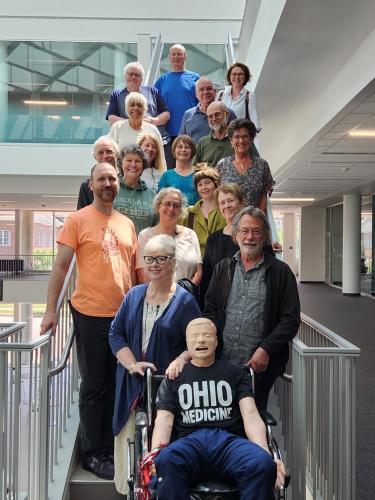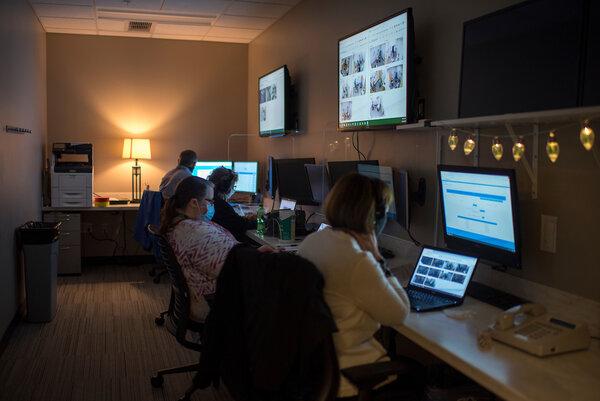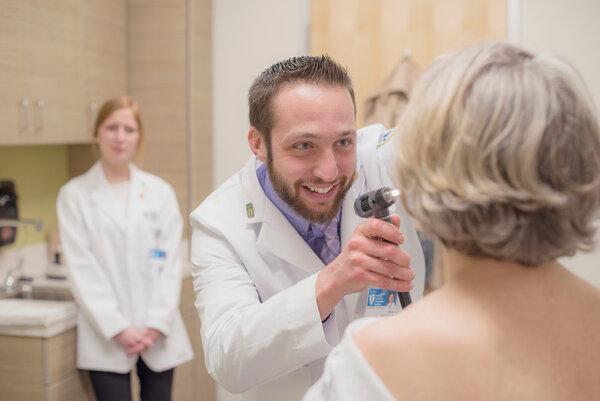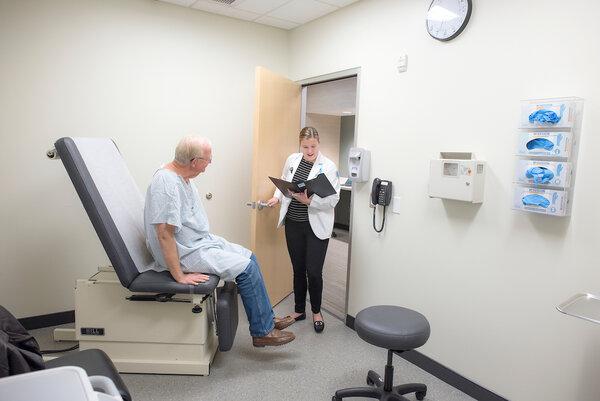
Heritage College of Osteopathic Medicine standardized patients stay on script

Behind the scenes looks like something out of a spy film.
TV screens display live surveillance footage inside a small, dimly lit control room to three hidden observers. As they watch, they take down notes while keeping an eye out for hand signals indicating potential technical issues as a timer ticks down.
“Two minutes remaining,” calls the moderator.
With this cue, the white-coated figures on screen wrap up conversations with their patients and step into the hallway to quickly log their session notes. The atmosphere feels tense as the timer resets, and these Ohio University Heritage College of Osteopathic Medicine students complete their records.
Meanwhile, in the break room, the standardized patients with whom the D.O.s-in-training interacted, seem completely relaxed–out of their medical gowns, leaning back in their seats. Some exchange stories of past sessions, laughing, while others simply focus on what they might order for lunch during this break between exams. They have just completed one of eight sessions for the day, and soon they will step back into the simulated exam room for the next group of students who are completing their final examinations.
Another day on the job.

Standardized patients (SPs) are people of all ages and backgrounds working with the Heritage College to train medical students in simulated health care environments. SPs pretend to have various medical conditions to give students valuable patient-provider interactions, allowing them to practice their communication skills before entering real-world medical settings. The SP program at OHIO has been providing formative experiences to medical students for over a decade, and it is due in no small part to the dedicated staff of SPs across the college’s campuses in Athens, Cleveland and Dublin.
Director of Experiential Learning Rachel Clift and staff help to operationalize opportunities for student success by facilitating the introduction of patient encounters to SP labs as early in their medical training as possible.
“Our year one students are given standardized patient experiences the first week of classes,” said Clift. “It is really to set the tone for these students to be able to feel comfortable knocking on a door, introducing themselves and have that engagement with a patient.”
Communication is a key component of being a successful caregiver. Possessing the ability to empathize, deliver difficult news or even simply lend an ear to a concerned patient can make or break a medical encounter. For this reason, simulated experiences, like SP labs, are crucial as they allow students to hone these skills before practicing on real patients.
According to Clift, after their initial sessions in week one, students continuously participate in SP labs at least once every other week until the end of their second year of training. Scripts are developed for these sessions by Heritage College faculty and designed to align with students’ coursework, so they may apply their newly acquired medical knowledge to real cases.
In some cases, lab coordinators may also request SPs from specific demographics (i.e., only female patients, or only patients 50 or older) to fit the needs of the lab taking place on a given day. This not only provides SPs with flexible hours but also ensures that students are exposed to patients from a variety of backgrounds and can understand the unique needs of various identity groups.
“We try to build diverse populations so that our medical students are seeing populations they would see in the community when they go into practice,” said Clift.
SP work can be emotionally and physically taxing. An SP may work as many as eight sessions in one day—up to eight hours to provide students with physical examination and procedural experience. These may be non-invasive interactions or invasive gynecologic/genitourinary examinations. For the SPs who volunteer to participate in the invasive exams, the hourly pay rate is raised from $25 to $80 to compensate for the additional expectations.
Beyond enhancing clinical skills, students are also assessed on their ability to engage with patients, such as asking questions and picking up on cues that allow the student to properly treat and diagnose the SP. As such, SPs are only able to provide information outlined in their scripts, and only when properly prompted. In this way, SPs are not merely acting as patients, but serving as educators themselves.
Dan Myers has been working as an SP at the college’s Dublin campus for the past nine years. A retired educator with over three decades of experience, Myers takes great pride in aiding students along their medical school journey.
“You are educating these college students, and it’s not a joke,” said Myers. “I love the idea of being a part of their career, their education, their dreams.”
This is a sentiment carried by many of the SPs hired by the college–they take their work seriously knowing the integral role they play in the students’ education, and the health, safety and comfort of any patients those students may treat throughout their career.
“It’s not easy work,” said Myers. “When we walk into that exam room, we’re a completely different person. I’m not Dan Meyers, I’m whatever name is on that script…this isn’t a cute little exercise we’re doing here.”
For Kimetta Davis, an SP for the college’s Cleveland campus, health care communication is not a subject she takes lightly. Since she was ten years old, Davis recalls taking care of ailing family members, including her own mother.
“My mom had doctors that were good communicators, and I noticed she felt a lot better talking to those particular health care workers, as opposed to someone who was not listening or condescending,” recalls Davis. “That, in and of itself, would make her feel worse…my thing was, and still is, you shouldn’t feel worse leaving the doctor than you did when you came in.”
Though acting experience is not a requirement, working as an SP for the past eight years has allowed Davis to embody roles in ways that make the experience more realistic for the students.

“I can actually make myself cry,” said Davis. “I make myself cry eight times in one day.”
The medical focus of SP sessions can range from routine check-ups to heavier topics, such as receiving a cancer diagnosis and domestic violence. After getting scripts which paralleled experiences from Davis’s own life, she began processing repressed emotions and eventually felt comfortable reaching out for support.
“It actually helped me…because of that, I started doing therapy. I’m bringing those things back up and working through them, and it’s truly because of those particular cases,” recalls Davis. “They have said to me, ‘if you don’t want to continue to do this, let us know.’ And I’ve said this is cathartic for me. So, not only am I helping someone, I’m being helped.”
Due to the nature of some of these subjects, the college offers campus and local resources to both SPs and students–emphasizing the importance of maintaining good mental health.
“We want to make sure we are building a quality program for our students, but also a safe place for our learners and our patients,” said Clift. “It’s a good evolution for our program to have, and we’ve gotten really good feedback.”
The social support from the college community is another significant aspect of the experience which keeps many SPs coming back.
“Ohio University has become a special place for me,” said Myers. His wife, who also served as an SP for the college, passed away five and a half years ago. “I can’t even begin to tell you how the staff, faculty, even the students at Heritage reached out to me–it was like family. I feel like I’m with family when I’m at OU.”
Steve Gray, a retired nurse and SP for the college’s Athens campus, also highlighted the sense of community he feels.
“There is a camaraderie that develops after a while,” said Gray. “It’s nice, because as you’re retired, you get a little more isolated…I enjoy the contact with the students and also with my peers.”
Gray worked as a nurse in Athens for 40 years, with the latter half of this time spent as an ER nurse. He retired from full-time work in 2018 but continued to pick up occasional shifts until 2020 when he was advised to fully retire due to the unsafe conditions created by the COVID-19 pandemic. Not wanting to completely stop working, however, Gray became an SP in 2021, lending his medical knowledge and experience to the next generation of care providers.
In addition to his standardized patient work, once a year, Gray also teaches nursing skills to medical students at Heritage College. This dynamic, according to Gray, can sometimes complicate the SP interaction.
“I’ve had laughs because I know them and have been teaching them, but as in the lab, everybody knows the game,” recalls Gray. “I do still find myself helping them with the blood pressure cuff because I know how awkward it can be.”
Tracy Wood also possesses medical training, which she used both by serving as a medical assistant and in cases of emergency, as the owner of a hiking company in Sedona, Arizona. Now an SP for Heritage College’s Athens campus, she finds that strong acting skills has been an asset.

“Even more important than having any sort of medical training is being able to adapt to all the different scripts that we do throughout the years,” said Wood. “There are days where you’re different people in the morning lab than you are in the afternoon, so keeping all of that straight can be a little bit challenging.”
SPs are constantly shapeshifting, adapting to the conditions their script calls for to best serve the medical students they train. On a given day, an SP may act as three or four patients, each with their own medical record to memorize. Keeping this straight may be a challenge, but it does not erase the actual person underneath, striving to help the student succeed.
“We’re all rooting for the students to do well,” said Wood. “That being said, you know they’re there for a reason, and that’s to get them comfortable with face-to-face interactions with real people…today, everything is sort of, I would say, anything but face-to-face. It’s easy to not have a lot of interaction with a diverse group of people, but all the SPs are so different and it’s really amazing to get the student doctors ready for real world environments.”
Some standardized patients, like Crystal Minshall, occasionally encounter students outside the lab in a real clinical setting.
“I have seen students I’ve worked with at OU at my actual family doctor,” said Minshall. “I just thought it was really neat and made me happy to see them out there doing their thing and knowing that I had a little part in that.”
Minshall is a home health aide and an SP for the college’s Dublin campus. After nearly a decade working with students in this role, she sometimes finds herself forgetting to change her mindset.
“Sometimes when I go to my regular doctor, I have to remember that I’m not at work, I’m not a standardized patient,” she said.
Ultimately, she has found this work not only rewarding but personally beneficial as well.
“You really learn fast how to open up; it helps me communicate with people out in public, and it really has helped my memory as well,” said Minshall “I have learned a lot being a standardized patient.”
When the break between exams is over, the SPs step back into their blue medical gowns ready for the next role they’ll play and the next student who will walk through the door.
“I think I’d do this job for nothing,” said Myers. “I’m proud of what I do, I’m proud of the program, and I’m proud of the students that are a part of the program.”
